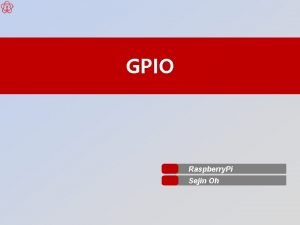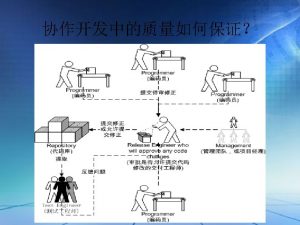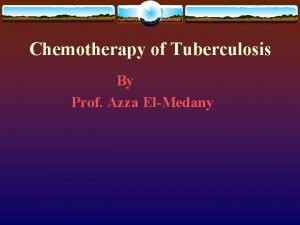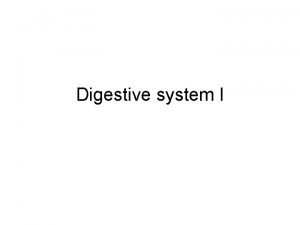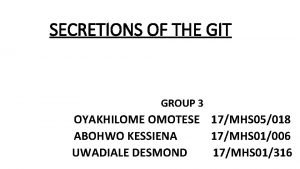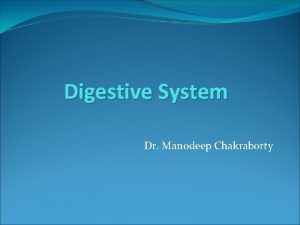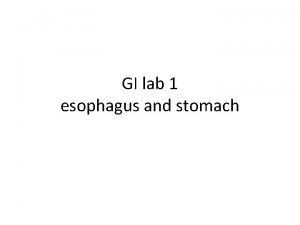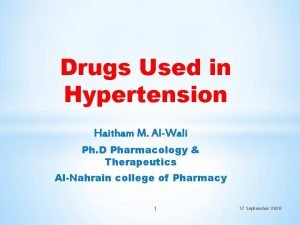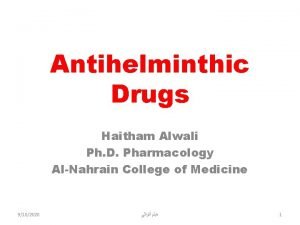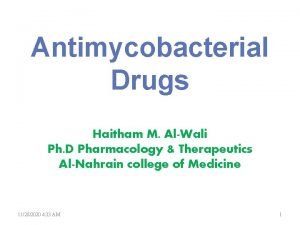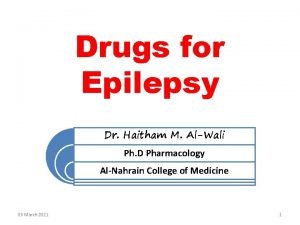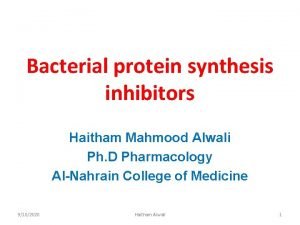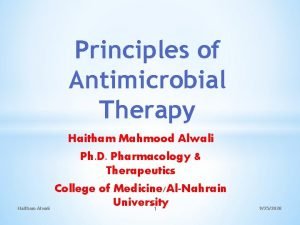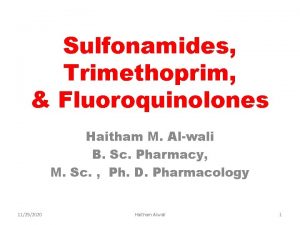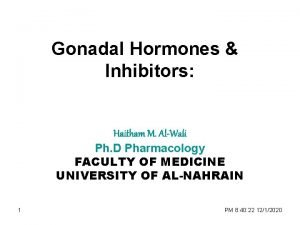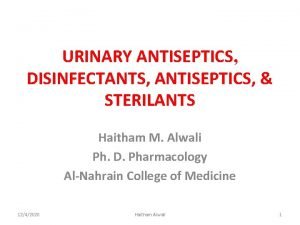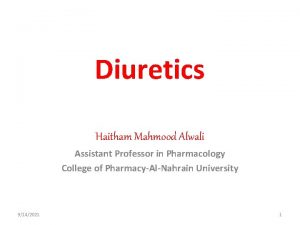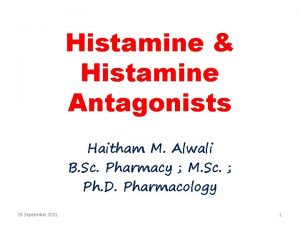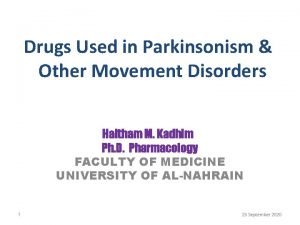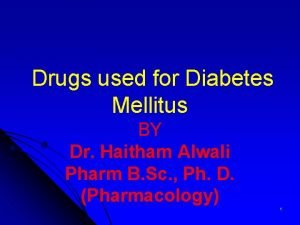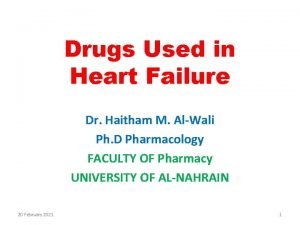Drugs used in GIT disorders Haitham Alwali Ph


















- Slides: 18

Drugs used in GIT disorders Haitham Alwali Ph. D. Pharmacology Al-Nahrain College of Pharmacy 6/3/2021 Haitham Alwali 1

6/3/2021 Haitham Alwali 2

A. Drugs Used in Acid-Peptic Diseases Ø Ulceration and erosion of the lining of the upper portion of the gastrointestinal tract are common problems that manifest as gastroesophageal reflux disease (GERD), gastric and duodenal peptic ulcers, and stress-related mucosal injury. Ø Drugs used in acid-peptic disease reduce intragastric acidity by manipulating systems controlling acid secretion, promote mucosal defense or, in the case of peptic ulcers, eradicate the bacterium Helicobacter pylori, which is detectable in over 80% of patients with duodenal ulcers. 6/3/2021 Haitham Alwali 3

1. Antacids: are weak bases that neutralize stomach acid by reacting with protons in the lumen of the gut and may also stimulate the protective functions of the gastric mucosa. antacids reduce the recurrence rate of peptic ulcers. Ø Popular antacids include magnesium hydroxide (Mg[OH]2) and aluminum hydroxide (Al[OH]3). Neither of these weak bases is significantly absorbed from the bowel. Magnesium hydroxide has a strong laxative effect, whereas aluminum hydroxide has a constipating action. These drugs are available as single-ingredient products and as combined preparations. 6/3/2021 Haitham Alwali 4

Ø Calcium carbonate and sodium bicarbonate are also weak bases, but they differ from aluminum and magnesium hydroxides in being absorbed from the gut. Because of their systemic effects, calcium and bicarbonate salts are less popular as antacids. 2. H 2 -receptor antagonists—Cimetidine and other H 2 antagonists (ranitidine, famotidine, and nizatidine) inhibit stomach acid production, especially at night. They are effective in the treatment of GERD, peptic ulcer disease, and nonulcer dyspepsia and in the prevention of stressrelated gastritis. 6/3/2021 Haitham Alwali 5

3. Proton pump inhibitors—Omeprazole and (esomeprazole, (dex) lansoprazole, pantoprazole, and rabeprazole) are lipophilic weak bases that diffuse into the parietal cell canaliculi, where they become protonated and concentrated more than 1000 -fold. There they undergo conversion to compounds that irreversibly inactivate the parietal cell H+/K+ ATPase, the transporter that is primarily responsible for producing stomach acid. 6/3/2021 Haitham Alwali 6

Oral formulations of these drugs are enteric coated to prevent acid inactivation in the stomach. After absorption in the intestine, they are rapidly metabolized in the liver, with half-lives of 1– 2 h. However, their durations of action are approximately 24 h, and they may require 3– 4 d of treatment to achieve their full effectiveness. Proton pump inhibitors are more effective than H 2 antagonists for GERD and peptic ulcer and equally effective in the treatment of nonulcer dyspepsia and the prevention of stress-related mucosal bleeding. They are also useful in the treatment of Zollinger. Ellison syndrome. 6/3/2021 Haitham Alwali 7

Adverse effects of proton pump inhibitors Ø occur infrequently and include diarrhea, abdominal pain, and headache. Chronic treatment with proton pump inhibitors may result in hypergastrinemia. Ø Proton pump inhibitors may decrease the oral bioavailability of vitamin B 12 and certain drugs that require acidity for their gastrointestinal absorption (eg, digoxin, ketoconazole). Ø Patients taking proton pump inhibitors may have a small increase in the risk of respiratory and enteric infections. 6/3/2021 Haitham Alwali 8

6/3/2021 Haitham Alwali 9

4. Sucralfate— An aluminum sucrose sulfate, sucralfate is a small, poorly soluble molecule that polymerizes in the acid environment of the stomach. The polymer binds to injured tissue and forms a protective coating over ulcer beds. Sucralfate accelerates the healing of peptic ulcers and reduces the recurrence rate. 5. Misoprostol—An analog of PGE 1, misoprostol increases mucosal protection and inhibits acid secretion. It is effective in reducing the risk of ulcers in users of non steroidal anti-inflammatory drugs (NSAIDs). 6/3/2021 Haitham Alwali 10

6. Antibiotics—Chronic infection with H pylori is present in most patients with recurrent non-NSAID -induced peptic ulcers. Eradication of this organism greatly reduces the rate of recurrence of ulcer in these patients. One regimen of choice consists of a proton pump inhibitor plus a course of clarithromycin and amoxicillin (or metronidazole in patients with penicillin allergy). 6/3/2021 Haitham Alwali 11

B. Drugs That Promote Upper Gastrointestinal Motility § Their ability to increase lower esophageal sphincter pressures also makes them useful for some patients with GERD. Ø In the enteric nervous system, dopamine inhibits cholinergic stimulation of smooth muscle contraction. Metoclopramide and domperidone are D 2 dopamine receptor antagonists that promote gastrointestinal motility. Ø When used chronically, metoclopramide can cause symptoms of parkinsonism, other extrapyramidal effects, and hyperprolactinemia. Because it does not cross the bloodbrain barrier, domperidone is less likely to cause CNS toxicity. Ø The macrolide antibiotic erythromycin promotes motility by stimulating motilin receptors. 6/3/2021 Haitham Alwali 12

C. Laxatives: Mechanism Examples 1 -Bulk-forming Psyllium, methylcellulose 2 -Stool-softening glycerin, mineral oil 3 -Osmotic Magnesium oxide, lactulose, 4 -Stimulant Aloe, senna, cascara, castor oil, bisacodyl 5 -Chloride channel activator 6/3/2021 Lubiprostone Haitham Alwali 13

D. Antidiarrheal Agents Diphenoxylate and loperamide, meperidine analogs with very weak analgesic effects. Diphenoxylate is formulated with antimuscarinic alkaloids (eg, atropine) to reduce the likelihood of abuse; loperamide is formulated alone. Kaolin, a naturally occurring hydrated magnesium aluminum silicate, is combined with pectin, an indigestible carbohydrate derived from apples ( absorbs bacterial toxins and fluid, resulting in decreased stool liquidity. these agents should not be used in patients with bloody diarrhea, high fever, or systemic toxicity because of the risk of worsening the underlying condition. 6/3/2021 Haitham Alwali 14

E. Drugs Used for Irritable Bowel Syndrome(IBS) is associated with recurrent episodes of abdominal discomfort (pain, bloating, distention, or cramps) plus diarrhea or constipation (or both). Ø The pharmacologic strategy includes antidiarrheal agents OR laxatives; and for the treatment of abdominal pain, low doses of tricyclic antidepressants Ø dicyclomine and hyoscyamine are used as antispasmodics to relieve abdominal pain Ø Alosetron, a potent 5 -HT 3 antagonist, is approved for treatment of women with severe IBS with diarrhea. Ø Lubiprostone, a laxative that activates the type 2 chloride channels in the small intestine. 6/3/2021 Haitham Alwali 15

F. Drugs With Antiemetic Actions Ø In addition to metoclopramide and other D 2 dopamine receptor antagonists, useful antiemetics are drugs with H 1 histamine blocking activity (diphenhydramine), and several phenothiazines; antimuscarinic drugs such as scopolamine ; the corticosteroid dexamethasone ; and the cannabinoid receptor agonists dronabinol. Ø The 5 -HT 3 antagonists ondansetron, granisetron, dolasetron are useful in preventing nausea and vomiting after general anesthesia and in patients receiving cancer chemotherapy. Ø Aprepitant, a newer antiemetic, is an antagonist of the neurokinin 1 (NK 1) receptor, a receptor in the CNS that is activated by substance P and other tachykinins. 6/3/2021 Haitham Alwali 16

G. Drugs Used in Inflammatory Bowel Disease (IBD) 1. Aminosalicylates—Drugs containing 5 aminosalicylic acid (5 -ASA) are used as topical therapy for IBD. The precise mechanism of 5 -ASA action is uncertain but may involve inhibiting the synthesis of prostaglandins and inflammatory leukotrienes. Balsalazide and sulfasalazine (a combination of 5 -ASA and sulfapyridine) has a higher incidence of adverse effects (sulfapyridine moiety) include gastrointestinal upset, headaches, arthralgias, bone marrow suppression, and severe hypersensitivity reactions 2. Other agents: include antibiotics, glucocorticoids (budesonide), immunosuppressive antimetabolites (eg, azathioprine, methotrexate) antitumor necrosis factor [TNF] drugs (eg, infliximab, adalimumab). 6/3/2021 Haitham Alwali 17

H. Pancreatic Enzyme Replacements: Steatorrhea, a condition of decreased fat absorption together with an increase in stool fat excretion, results from inadequate pancreatic secretion of lipase. Ø The abnormality of fat absorption can be significantly relieved by oral administration of pancreatic lipase (pancrelipase or pancreatin) obtained from pigs. Ø Pancreatic lipase is inactivated at a p. H lower than 4. 0; the enzyme should be taken as enteric-coated capsules. I. Drugs That Inhibit the Formation of Gallstones The formation of cholesterol gallstones can be inhibited by the bile acid derivative ursodiol, which decreases the cholesterol content of bile by decreasing hepatic cholesterol secretion. 6/3/2021 Haitham Alwali 18
 라즈베리 gpio
라즈베리 gpio Haitham hassanieh
Haitham hassanieh Seven trays in labour room
Seven trays in labour room Teratogens images
Teratogens images Git commit
Git commit Git prophylaxis
Git prophylaxis Oneflow github
Oneflow github Git branching strategy
Git branching strategy Git in biochemistry
Git in biochemistry Rapidjson github
Rapidjson github Portal circulation
Portal circulation Java eclipse gitignore
Java eclipse gitignore Glucagon mechanism of action
Glucagon mechanism of action Versionsstyring
Versionsstyring Git secretions
Git secretions Git object model
Git object model Ginivitis
Ginivitis Stomach
Stomach Picasso github
Picasso github
